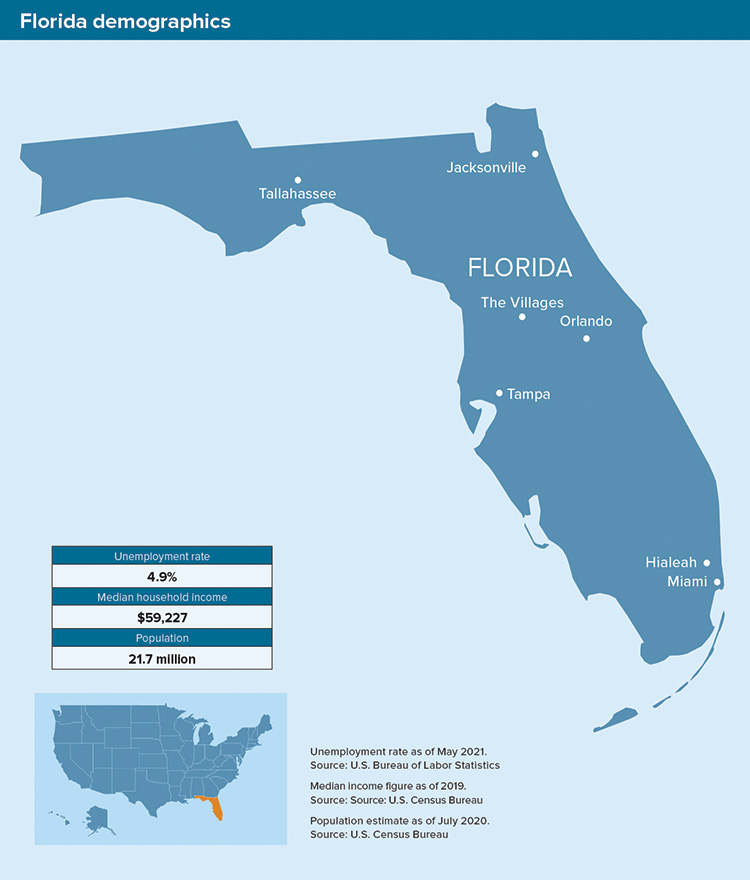Spanish explorer Juan Ponce de Leon set off for the New World looking for gold and the Fountain of Youth. By at least one historical account, his expedition arrived on a stretch of land on Easter Sunday in April 1513, a day of celebration often called La Pascua de las Flores or the festival of flowers. He named the land La Pascua Florida and the name stuck.
De Leon never found gold or the Fountain of Youth. The true treasure was the land. Today, Florida is the third most-populous state in the U.S. with 21.7 million residents. It also has one of the largest economies of any state.
 Florida ranked fourth in the nation last year by generating $1.095 trillion in gross domestic product (GDP), or the sum of all goods and services, according to the U.S. Department of Commerce. The state’s economy declined by 2.9% in 2020 compared to the prior year. Every state in the U.S. saw a decline in GDP last year due to widespread struggles with the COVID-19 pandemic. As a whole, U.S. GDP declined by 3.5% last year.
Florida ranked fourth in the nation last year by generating $1.095 trillion in gross domestic product (GDP), or the sum of all goods and services, according to the U.S. Department of Commerce. The state’s economy declined by 2.9% in 2020 compared to the prior year. Every state in the U.S. saw a decline in GDP last year due to widespread struggles with the COVID-19 pandemic. As a whole, U.S. GDP declined by 3.5% last year.
As of late this past June, Florida accounted for 2.3 million coronavirus cases, the third most in the U.S. behind California and Texas. The Sunshine State also ranked No. 4 in the nation at this time for total number of COVID-19 deaths with nearly 38,000. Florida fared better when measured by most cases per 100,000 residents, ranking No. 21 among all states.
Economically speaking, the pandemic hit tourism-dependent states especially hard, and this is true for Florida. Millions flock to Florida’s beaches, Walt Disney World in Orlando and Kennedy Space Center in Cape Canaveral. They also fly into the state to board cruise ships headed to the Caribbean.
The state saw a 34% year-over-year decrease in visitors in 2020. About 87 million people visited the Sunshine State last year, down from 131.4 million in 2019. That’s the lowest number Florida has recorded since 2010 when the country was in the throes of the Great Recession.
With travel restrictions still in place across many other parts of the world, U.S. travelers were expected to flock to domestic locations this summer and fall, which could be a boon for Florida. The pandemic has benefited the state in at least one way. Miami is gaining a reputation as “Wall Street South,” a branding that accelerated during the past year as many financial companies and professionals fled New York to set up shop in Florida. Whether these Wall Street A-listers remain in the Sunshine State post-pandemic remains to be seen. ●
Florida Single-Family Home Sales
 Home prices and the number of homes sold in the Sunshine State have been rising over the past several years. In 2020, the median sales price for a single-family home in Florida was $290,000, up 63% from six years earlier, according to Florida Realtors.
Home prices and the number of homes sold in the Sunshine State have been rising over the past several years. In 2020, the median sales price for a single-family home in Florida was $290,000, up 63% from six years earlier, according to Florida Realtors.
Sales of single-family homes also have been on an upward trajectory, rising from 240,500 in 2014 to 310,378 last year — a 29% increase. Florida, like many states, is suffering from a lack of homes for sale. Inventory of existing single-family homes rose slightly in May 2021, the first increase in more than a year, according to Florida Realtors.
Prices jumped even further in first-quarter 2021. The median sales price for a single-family home in Florida rose to $317,500. For comparison, the typical single-family home value in the U.S. was about $278,000 at the end of this past March, according to Zillow.
The rise in prices has led to questions about a bubble forming in the Sunshine State. These fears are being tamped down by real estate experts who say conditions are a product of inventory shortages at a time when millennials are reaching homebuying ages.
Focus: Cruise industry
Nearly 14 million passengers sailed from U.S. ports in 2019 via cruise ships. About 8.3 million of these passengers — or 60% — left from ports in Florida. With the largest cruise terminal in the world at Port Miami, the cruise industry is big business in the Sunshine State.
The industry employs 158,000 workers across Florida, or three times as many as California, the next closest state. Cruising also accounted for $9 billion in direct expenditures in Florida in 2019, according to the Cruise Lines International Association. This is why the ban that lasted for more than a year on cruising from U.S. ports crippled shipping lines, vendors and employees, and dealt Florida such a heavy blow.
Cruise operators were making plans to resume sailing this summer, but a spat over whether passengers must be vaccinated was causing what one newspaper called an “ocean of confusion.” Florida Gov. Ron DeSantis threatened to fine operators that require vaccinations, setting up a legal battle with the federal government, which wants the vast majority of passengers and crew members to be vaccinated.
What the locals say
“There’s more people from the Northeast and Chicago moving to Florida than I’ve ever seen, a lot of Wall Street people who can work remotely now. These people are in their 30s, 40s and 50s, in the prime of their careers, and they’re able to move because of the pandemic. I remember talking to my team in March 2020 and said, ‘Guys, all we’re going to do is help people. The rates are low. We can help them save money and survive this.’ As more people kept their jobs, the purchase market just caught fire.”

Tony Umholtz
Mortgage loan officer,
IberiaBank
3 Cities to Watch
Hialeah
 In the early 1900s, a Seminole Indian named Willie Willie described to a developer the land where this city sits as “hialeah,” or “high prairie” in his native tongue. The name stuck. Today, Hialeah is a suburb of Miami and is the sixth largest city in Florida with a population of 233,000. It’s also the heart of Cuban American culture in South Florida as 95% of its population identifies as Hispanic or Latino. The city’s median household income is $35,068.
In the early 1900s, a Seminole Indian named Willie Willie described to a developer the land where this city sits as “hialeah,” or “high prairie” in his native tongue. The name stuck. Today, Hialeah is a suburb of Miami and is the sixth largest city in Florida with a population of 233,000. It’s also the heart of Cuban American culture in South Florida as 95% of its population identifies as Hispanic or Latino. The city’s median household income is $35,068.
Tampa
 Development of the Tampa Bay region by white settlers didn’t happen until after Florida became a state in 1845. Now, Tampa is the third largest city in the state and has a metro-area population of 3.1 million, which is expected to grow to 3.8 million by 2040. Major employers include Publix Super Markets, headquartered east of Tampa in Lakeland, with 22,000 workers; BayCare Health System (17,000); and TECO Energy (4,900). The city’s median household income is $53,833.
Development of the Tampa Bay region by white settlers didn’t happen until after Florida became a state in 1845. Now, Tampa is the third largest city in the state and has a metro-area population of 3.1 million, which is expected to grow to 3.8 million by 2040. Major employers include Publix Super Markets, headquartered east of Tampa in Lakeland, with 22,000 workers; BayCare Health System (17,000); and TECO Energy (4,900). The city’s median household income is $53,833.
The Villages
 The fastest-growing city in America over the previous decade was The Villages, a master-planned community founded more than 30 years ago and mainly designed for residents 55 and older. The Villages added nearly 40,000 people between 2010 and 2019, and now has 132,000 residents. The population growth has helped fuel a regional economic expansion. The Villages encompasses much of Sumter County, which has a median income of $57,226.
The fastest-growing city in America over the previous decade was The Villages, a master-planned community founded more than 30 years ago and mainly designed for residents 55 and older. The Villages added nearly 40,000 people between 2010 and 2019, and now has 132,000 residents. The population growth has helped fuel a regional economic expansion. The Villages encompasses much of Sumter County, which has a median income of $57,226.
Sources: Anchorage Daily News; Bloomberg; City of Tampa; Cruise Lines International Association; Florida Realtors; Forbes; Insider; JSTOR Daily; Miami Herald; Scriberr; Tampa Bay Economic Development Council; Tampa Bay Times; Tampa Commercial Real Estate; The Daytona Beach News-Journal; The New York Times; The Palm Beach Post; The Villages Daily Sun; U.S. Bureau of Economic Analysis; U.S. Bureau of Labor Statistics; U.S. Census Bureau; USA Today; World Population Review; Zillow







